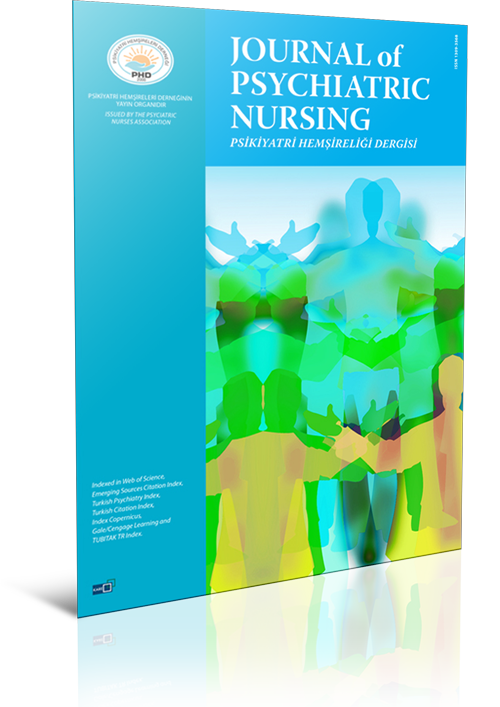
Volume: 2 Issue: 2 - 2011
| 1. | Frontmatter Pages I - III |
| RESEARCH ARTICLE | |
| 2. | High School Students Perception of Violence, Level of Tendency to Violence and Effective Factors Gönül Özgür, Gülden Yörükoğlu, Leyla Baysan Arabacı Pages 53 - 60 OBJECTIVE: Violence is gradually increasing in our country despite precautions taken and disciplinary rules. From past to present, fighting among students and damage to school property in the elementary and high school periods have been reported. Yet, in recent years, violence of different levels and type has reached a new dimension that should be a cause of concern to not only parents and educators but society in general. The reality that violence experienced at schools affects the students life quality and level of success is important and should not be ignored. In this regard, this research was conducted in order to determine the high school students experiences with violence and means of avoiding it, their level of tendency to violence and the effective factors. METHODS: After obtaining the necessary permissions, this descriptive research was carried out with students (N=460) studying in a high school in Kuşadası, a subsidiary of the city of Aydın. No sampling choice was used. The participation rate was 78.3% (360 students). Student Identification Form and Violence Tendency Scale (VTS) were used in the research. Data were evaluated using number-percentage distribution, Mann-Whitney U test and Kruskal-Wallis test analysis. RESULTS: It was determined that 10.3% of the students were exposed to violence and more than half of these students (51.4%) experienced this violence from friends at school. The most frequent type of violence was stated as physical and the perceived source as beating. The students VTS average score was 44.08±12.48. It was determined that the factors affecting tendency to violence were the students gender, their grade level, their familys level of income, and their fathers employment status. CONCLUSION: Although the students reported little exposure to violence, their tendency to violence was at medium level, they comprise a group at risk of violence, and the students economic situation in addition to gender, grade level and paternal unemployment were the effective factors in the tendency to violence. |
| 3. | Quality of Life and Effective Variables Among Health Care Professionals Arzu Yıldırım, Rabia Hacıhasanoğlu Pages 61 - 68 OBJECTIVE: This study was conducted to determine the effect of burnout, depression, and sociodemographic and occupational characteristics on quality of life among health care professionals. METHODS: This cross-sectional study was conducted with 311 health care professionals employed at five Family Health Centers and Erzincan State Hospital in central Erzincan between May and June 2010. Data were collected using a questionnaire, Maslach Burnout Inventory (MBI), Beck Depression Inventory (BDI), and the Turkish version of the World Health Organization Quality of Life Instrument (WHOQOL-BREF-TR). For analysis of the data, univariate analysis, Pearson correlation and multiple linear regression analysis were used. RESULTS: In this study, there was a weak-positive statistically significant relationship between the BDI and MBI (p<0.001), a moderate-negative relationship between the WHOQOL-BREF-TR and BDI, and a weak-negative relationship between the WHOQOL-BREF-TR and MBI (p<0.001). Results of the regression analysis revealed that BDI, Diminished Personal Accomplishment (DPA) and economic problems were significant predictor variables for the physical sub-domain; BDI, DPA, work-years, dissatisfaction with work life, and perception of success in the institution for psychological sub-domain; BDI, DPA, emotional exhaustion (EE), marital status, educational status, place of work, and communication problems for social sub-domain; and BDI, DPA, marital status, and gender for environmental sub-domain. CONCLUSION: In this study, it was determined that depression and burnout levels of health care professionals were low and quality of life was medium. It was also determined that depression, burnout and some of the variables have a negative impact on the quality of life. |
| 4. | Comparison of Nurses and Patients Opinions about Their Experiences During the Disease Process of Inpatients in the Intensive Care Unit Çiğdem Alaca, Rana Yiğit, Ayşe Özcan Pages 69 - 74 OBJECTIVE: This study aimed to determine the feelings and thoughts of patients during their illness and to understand how they are evaluated by nurses. Furthermore, it was also aimed to investigate whether or not consultation liaison psychiatric (CLP) nursing is necessary. METHODS: This study included 100 patients in intensive care units (ICUs) and 79 nurses working in these units. The data from the patients was collected by the researcher using an interview form and the Hospital Anxiety and Depression Scale. The data from the nurses was gathered through a questionnaire. RESULTS: Seventy-two percent of the patients had depression and 42% had anxiety. Fifty percent of the patients associated the ICU with death. Sixty-nine percent of the patients said that the nurses did not understand their feelings or speak or listen to them, but rather focused mainly on their jobs. The nurses stated that they associated the ICU with serious illnesses (59.5%), they could help the patients who suffered from any difficulties (84.8%), and that they desired to work with the CLP nurses (92.4%). CONCLUSION: We observed in this study that the patients are afraid and think about death during the disease process, and that the nurses are aware of their patients feelings but cannot empathize with them. It has been suggested to make the application of CLP nursing prevalent in order that nurses can better evaluate the patients feelings and provide them with holistic care. |
| 5. | The Relationship Between Emotional Intelligence Levels of Students and Problem- Solving Skills Elanur Yılmaz Karabulutlu, Sevda Yılmaz, Afife Yurttaş Pages 75 - 79 OBJECTIVE: This research was performed in order to determine the emotional intelligence and problem-solving skills of nursing students and the effect of students emotional intelligence levels on their problem-solving skills. METHODS: This research was made descriptively. 174 students who were educated in Ataturk University Erzurum Health Institute Nursing Department and who accepted to participate in the research were considered as the study subjects. The data of the research were collected in April 2007. For collecting data, a questionnaire form created for determining the significant features of students, an emotional intelligence scale and a problem-solving inventory were used. RESULTS: Among the sub-dimensions of the students emotional intelligence levels, optimism was scored as 63.13±8.53, taking advantage of emotions as 14.85±4.11, expression of emotions as 39.98±6.08, and total emotional intelligence level as 116.33±11.27. Problem-solving skill average score was determined as 92.08±18.69. A statistically significant negative relation was found between the total emotional intelligence score and the sub-dimensions and average score of problem-solving. CONCLUSION: It was determined that the emotional intelligence average score of nursing students was slightly above the average and that their problem-solving skill levels were intermediate. It was also determined that the problem-solving skills of students increase as their emotional intelligence levels increase. |
| REVIEW | |
| 6. | Electroconvulsive Therapy and Nursing Care Çiğdem Fulya Dönmez, Mualla Yılmaz Pages 80 - 89 Electroconvulsive therapy is an effective treatment method that is used to cure psychological diseases. However, some patients and their relatives may have negative views about electroconvulsive therapy. Electroconvulsive therapy has a frightening and negative connotation for patients because of their experience, the expressions of other patients who have been cured with the electroconvulsive therapy method, and the use by health personnel of the term shock treatment. Being supplied of therapeutic condition is the most important way of removing this anxiety and fear. In this report, we examine electroconvulsive therapy and nursing care. |
| 7. | Substance Use and Abuse Among Women Yasemin Kutlu Pages 90 - 93 Substance use and related problems are growing rapidly in both the world and our country. This situation creates serious problems due to the social, economic and health-related effects. The level and type of substance use may differ according to gender, age, race, family income, and role, etc. Gender is one of the most determining factors with respect to the start and progression of substance use. Although many studies on substance use related to gender may not offer accurate data, all these researches indicate that significantly more men are substance users than women. The implications of gender-based differences for prevention and treatment are largely unexplored. Recently, more studies in other countries have shown a need for women-focused approaches in the prevention and treatment of substance use in order to reduce the related effects. In Turkey, there is at present no prevention and treatment specifically focused on women regarding substance use because there are few data specifically concerning women. Because of differences in methods, these studies do not provide efficient information. This study reviews the frequency of substance use among women based on the current studies. |
| 8. | The Role of the Nurse in the Pre-op Psychosocial Assessment in Cosmetic Surgery Perihan Güner Küçükkaya Pages 94 - 99 Patients who revert to cosmetic surgery (CS) have varying expectations and reasons for electing this option. With growing interest in CS, proper screening of patients for this kind of surgery has become increasingly important. Individuals who have unrealistic expectations of CS are often found to be unsatisfied with the outcome regardless of the technical success of the surgery. Pre-existing psychosocial problems often contribute to post-surgical complications as well. Making a thorough psychosocial assessment prior to the surgery is useful in taking the necessary precautions, i.e. prevention or reduction of psychosocial problems and increasing patient satisfaction, leading to a successful surgical intervention for the appropriate patient. Research indicates nurses as having the primary role in the pre-op psychosocial assessment of CS patients, and the importance of this type of assessment for the success of the surgery itself is also stressed in the literature. In this article, the importance of psychosocial assessment of CS candidates is discussed and a psychosocial assessment framework for the nurse is presented. |


















